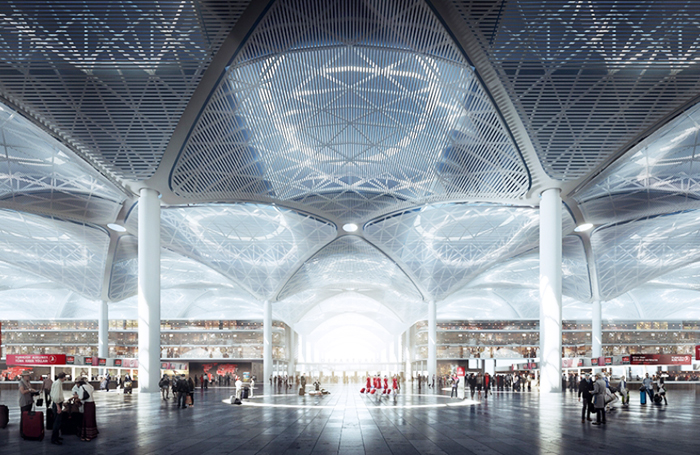One way a small practice can grow is by collaboration with larger, more experienced practices. To work on bigger projects or expand into other architectural sectors, working alongside other practices can be a big step forward.
Haptic Architects is one practice that successfully took this path. Over ten years, Haptic’s workload has expanded and its reputation grown via a series of collaborations with other practices – often on major infrastructure projects.
Their co-founder, Tomas Stokke, will be talking about ‘How to punch above your weight using strategic collaboration’ at Smart Practice: New Ways of Working on 1 October 2019.
The practice’s interest in collaboration grew out of necessity, he explains. Haptic began in a recession-struck London in 2009. Faced with a shortage of work, Haptic decided to open a second office in Oslo. They started reaching out to some friendly offices in the hope of sharing work.
"We realised we needed alliances to grow the practice," says Stokke. "Our first collaborations tended to be on projects that were uncertain and where no-one was sure whether they would happen."
Opening a second office was a risky move for a young practice but, Stokke states, less risky than doing nothing. Haptic was approached by a Norwegian practice to do a feasibility study for a proposed Arctic Circle Airport.
The original architect was already stretched and the fee on offer was low. However, Haptic’s successful work on the project led to a series of airport design collaborations, most of them with Nordic – Office of Architecture.

Now twenty-strong, Haptic has a list of impressive residential, government, leisure, and infrastructure credits to its name. It has worked with Grimshaw Architects on Istanbul Grand Airport, the world’s largest aviation hub, and is also partnering with Grimshaw on its HS2 work, including the new Euston terminal.
But how do small practices break in to such collaborations and court partners who appear to be out of their league? Reminding yourself of any existing connections you have is the logical first step.
"Most architects will have some kind of connection to a bigger practice, through university friends or peers working at the practice," suggests Stokke. "Even if these people might not be at decision-making levels, most would probably be happy to make an introduction to a relevant partner or director."
"Teaching can also be a good way of building up networks," Stokke proffers. "You can meet a lot of interesting people connected to practice through universities, and you will teach a lot of students who will go on to work in practices or start their own."
Many architects are not natural networkers, and Stokke admits it is something he has trained himself to get better at. Conversations with potential collaborators can be struck up at the many gatherings architects regularly attend: events such as the London Festival of Architecture, MIPIM, New London Architecture, or talks at universities and other institutions.
Organising events at your own practice is also an effective way of raising your profile to potential collaborators.
"We organise self-initiated projects that attract an outside audience," reveals Stokke. "For example, we turned the roof of our building into an edible garden for the London Festival of Architecture a few years ago."
He counsels that you have to work to identify opportunities and find something that can be valuable to another practice. It might be a strength in public realm or materials, or a particular design sensibility.

When a practice has established itself, other collaborators will start knocking at your door. At Haptic the process has now gone full circle, and they find other practices coming to them for collaborations and invitations to bid for projects.
"Often collaborations will start with a competition. A practice might ask us if we would like to join forces with them and we might agree that going in together will increase our chance of getting shortlisted, or reduce the time risk in applying."
As Haptic gets bigger, Stokke says they look forward to helping to bring on smaller practices with their own fresh thinking.
"The practices that come to us are generally people we have met before in various different situations," Stokke explains. "It could be former study friends, former staff members, or people we have met at conferences, talks, and events."
They are proactive in encouraging potential collaborators to come forward.
"We might reach out to younger, interesting practices that we have seen work by – either published or at first-hand – and that we like. We always keep conversations going with larger and smaller practices and try to think of opportunities that might make sense."
Tickets for RIBA Smart Practice: New Ways of Working are now on sale, with early bird tickets available until 31 July 2019.
Thanks to Tomas Stokke, Director, Haptic Architects.
Text by Neal Morris. This is a Professional Feature edited by the RIBA Practice team. Send us your feedback and ideas
RIBA Core Curriculum Topic: Business, clients and services.
As part of the flexible RIBA CPD programme, Professional Features count as microlearning. See further information on the updated RIBA CPD Core Curriculum and on fulfilling your CPD requirements as an RIBA Chartered Member.
Posted on 27 June 2019.









